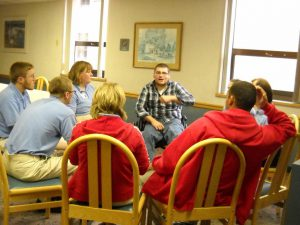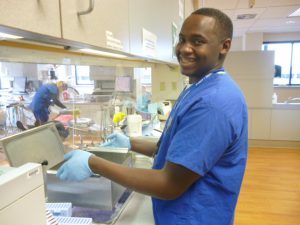Project SEARCH: Increasing Employment Opportunities for Young Adults with Autism
Landing your first full-time job can be challenging for anyone, but for people with autism it’s especially challenging. Two years after high school, more than half of young adults with autism are not employed, according to Autism Speaks.
People with autism have not only lower employment than non-disabled peers, but lower employment rates than their peers with other disabilities, according to researchers at the Autism Institute at Drexel University. Only 58 percent of young adults with autism ever worked between high school and their early 20s, compared to more than 90 percent of those with learning disability or emotional disturbance and nearly 75 percent of those with intellectual disability. And when young adults with autism are employed it is often in low-wage jobs and/or less than full-time employment.

The Project SEARCH Transition-to-Work program aims to help improve the odds for employment for young people with autism. Project SEARCH is an intensive nine-month job training program for young adults with autism or developmental disabilities. The goal for the program participant, called interns, is competitive employment.
Project SEARCH was developed at the Cincinnati Children’s Hospital Medical Center and now has program sites (with licensing agreements) in many locations around the country. The program involves extensive skills training, career exploration, innovative adaptions, job coaching and continuous feedback from teachers, trainers and employers.
Youth are embedded in a large community business, such as a hospital, government complex, or banking center. The host organization provides access to an onsite training room and the site is staffed by a special education teacher and one to three skills trainers. Project SEARCH interns rotate through a series of three targeted 10 to 12-week internships within the employer site. During the nine months, they log about 180 hours of classroom time and 700 hours of internship experience, learning marketable skills.

The program requires collaboration among participating students, their families, a local education agency, a host business, a local developmental disability agency and a state vocational rehabilitation agency.
A study by researchers at the Virginia Commonwealth University compared employment outcomes for a group of individuals with autism spectrum disorder. They compared a group receiving supported employment only with a group participating in Project SEARCH before receiving the supported employment services. Individuals participating in Project SEARCH required fewer hours of intervention, achieved a higher average wage and had higher retention rates than their peers who received supported employment only.
In addition to benefiting the participants, Project SEARCH and similar employment programs can contribute to change in the workplace. The active community/business involvement and experience of working with individuals with autism can lead to more knowledgeable, understanding and accepting workplaces. This can contribute to increased employment opportunities for people with autism and intellectual disabilities.
Resources and References
Autism Speaks Transition Toolkit
Schall, CM, et al. Employment interventions for individuals and ASD: The relative efficacy of supported employment with or without prior Project SEARCH training. Journal of Autism and Development Disorders. 2015. 45(12):3990-4001.
